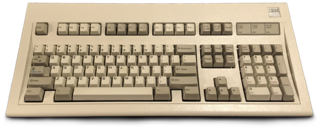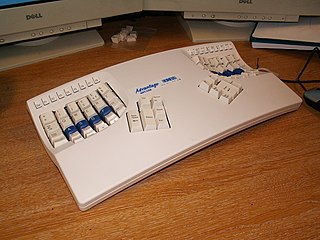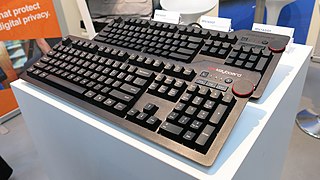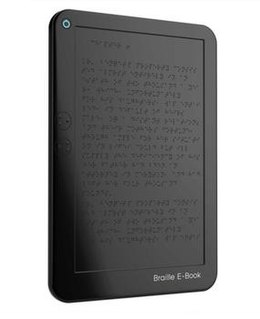
The technology of computer keyboards includes many elements. Among the more important of these is the switch technology that they use. Computer alphanumeric keyboards typically have 80 to 110 durable switches, generally one for each key. The choice of switch technology affects key response and pre-travel. Virtual keyboards on touch screens have no physical switches and provide audio and haptic feedback instead. Some newer keyboard models use hybrids of various technologies to achieve greater cost savings or better ergonomics.
In electrical engineering, a switch is an electrical component that can disconnect or connect the conducting path in an electrical circuit, interrupting the electric current or diverting it from one conductor to another. The most common type of switch is an electromechanical device consisting of one or more sets of movable electrical contacts connected to external circuits. When a pair of contacts is touching current can pass between them, while when the contacts are separated no current can flow.

Haptic technology, also known as kinaesthetic communication or 3D touch, refers to any technology that can create an experience of touch by applying forces, vibrations, or motions to the user. These technologies can be used to create virtual objects in a computer simulation, to control virtual objects, and to enhance remote control of machines and devices (telerobotics). Haptic devices may incorporate tactile sensors that measure forces exerted by the user on the interface. The word haptic, from the Greek: ἁπτικός (haptikos), means "tactile, pertaining to the sense of touch". Simple haptic devices are common in the form of game controllers, joysticks, and steering wheels.
The Model F was a series of computer keyboards produced mainly from 1981–1985 and in reduced volume until 1994 by IBM and later Lexmark. Its mechanical-key design consisted of a buckling spring over a capacitive PCB, similar to the later Model M keyboard that used a membrane in place of the PCB.

A buckling spring is a type of keyswitch mechanism, popularized by IBM's keyboards for the PC, PC/AT, 5250/3270 terminals, PS/2, and other systems. It was used by IBM's Model F keyboards, and the more common Model M. It is described in U.S. Patent 4,118,611 and U.S. Patent 4,528,431, both now expired.

Model M designates a group of computer keyboards designed and manufactured by IBM starting in 1985, and later by Lexmark International, Maxi Switch, and Unicomp. The keyboard's many variations have their own distinct characteristics, with the vast majority having a buckling-spring key design and swappable keycaps. Model M keyboards have been praised by computer enthusiasts and frequent typists due to their durability and consistency, and the tactile and auditory feedback they provide.

ZF Friedrichshafen AG, also known as ZF Group, originally Zahnradfabrik Friedrichshafen, and commonly abbreviated to ZF, is a German car parts maker headquartered in Friedrichshafen, in the south-west German state of Baden-Württemberg.

ZF Sachs AG, also known as Fichtel & Sachs, was founded in Schweinfurt in 1895 and was a well-known German family business. At its last point as an independent company, the company name was Fichtel & Sachs AG.

The Kinesis line of ergonomic computer keyboards is an alternative to the traditional keyboard design. Most widely known among these are the contoured Advantage line, which feature recessed keys in two bucket-like hollows which allow the fingers to reach keys with less effort as well as a central array of modifiers such as enter, alt, backspace, control, etc. where they can be pressed with the thumbs. All Kinesis keyboards support the capability to re-map individual keys. Recent models also come with the ability to switch between the Dvorak layout with the press of a special key combination, though keycaps printed with dual-legend QWERTY/Dvorak letters are included only on specific models. Moreover, the keys are laid out in perfect vertical rows to avoid the need for lateral movements during typing.

A membrane switch is an electrical switch for turning a circuit on and off. It differs from a mechanical switch, which is usually made of copper and plastic parts: a membrane switch is a circuit printed on Polyethylene terephthalate (PET) or Indium tin oxide (ITO). The ink used for screen printing is usually copper / silver / graphite filled and therefore conductive.

Automated manual transmission (AMT) is a type of transmission for motor vehicles. It is essentially a conventional manual transmission but uses automatic actuation to operate the clutch and/or shift between gears.

Das Keyboard is a series of computer keyboards sold by Metadot Corporation, a software company located in Austin, Texas. Some models feature blank keycaps, supposedly to help improve touch typing skills. The current iterations employ mechanical keyswitches manufactured by either Cherry or Greetech. It is worth to note that "the keyboard" in German is "die Tastatur", not "das Tastatur".
Unicomp is a manufacturer of computer keyboards and keyboard accessories, based in Lexington, Kentucky, United States.

G.SKILL International Enterprise is a Taiwanese computer hardware manufacturing company. The company's target customers are overclocking computer users. It produces a variety of high-end PC products and is best known for its DRAM products.

A computer keyboard is a peripheral input device modeled after the typewriter keyboard which uses an arrangement of buttons or keys to act as mechanical levers or electronic switches. Replacing early punched cards and paper tape technology, interaction via teleprinter-style keyboards have been the main input method for computers since the 1970s, supplemented by the computer mouse since the 1980s.
WABCO Holdings, Inc. is an American provider of electronic braking, stability, suspension and transmission automation systems for heavy duty commercial vehicles. Their products are present in many commercial vehicles as truck, bus, trailer and off-highway vehicles, but only fill niche roles.

A braille e-book is a refreshable braille display using electroactive polymers or heated wax rather than mechanical pins to raise braille dots on a display. Though not inherently expensive, due to the small scale of production they have not been shown to be economical.

Hi-Tek Corporation was an American electronics company based in California. At first making relays, actuators, and timers in the 1960s, the company pivoted to the manufacture of keyboard assemblies and discrete keyswitches in the late 1970s. They proved successful in the keyboard business, gaining clients such as Hewlett-Packard and Texas Instruments, and were acquired by Nippon Miniature Bearing in 1983.


















